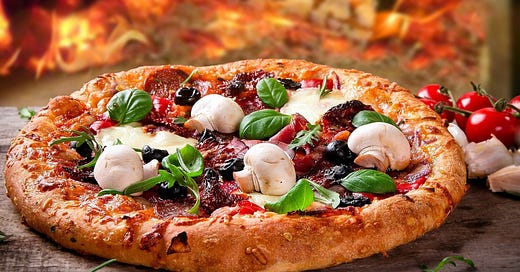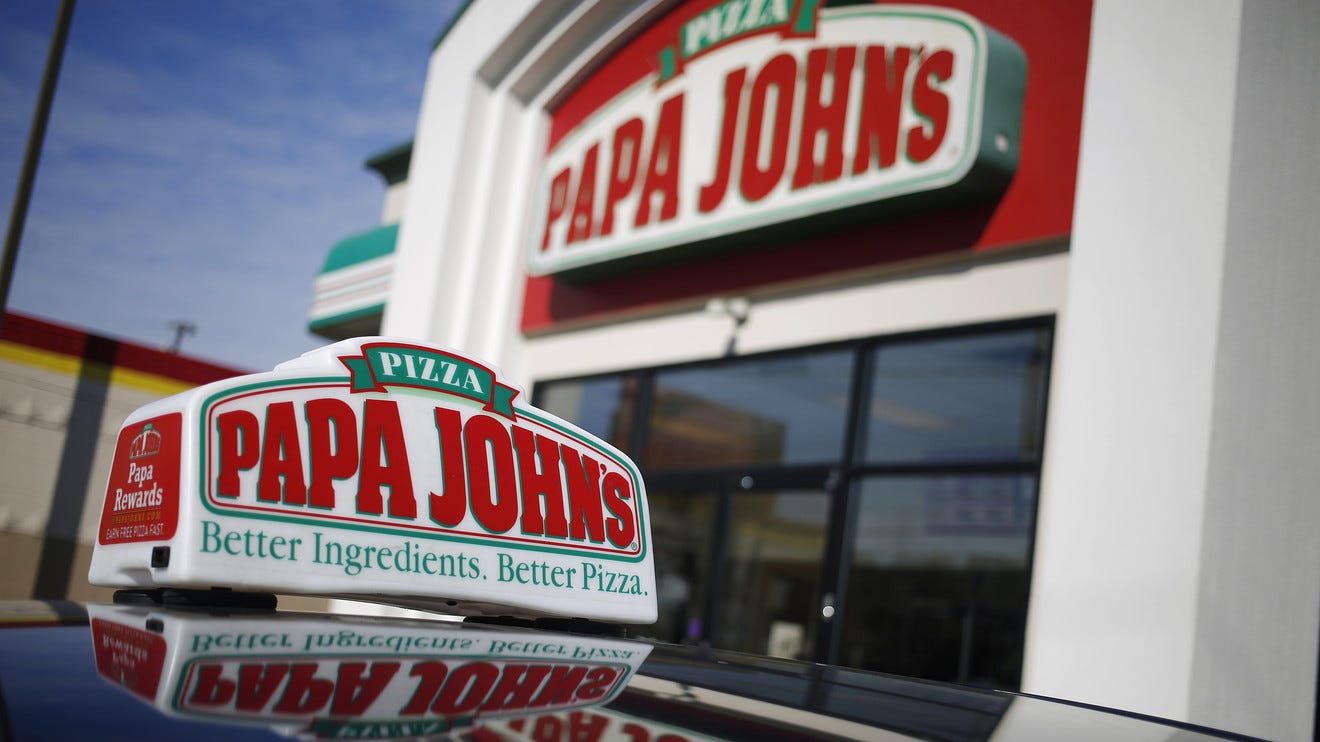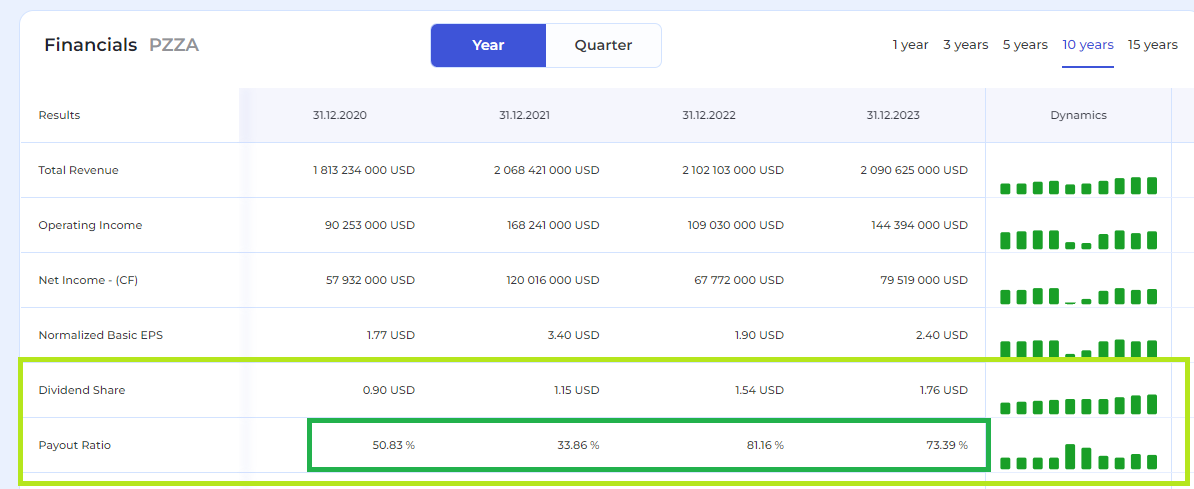MaxDividends Business Overview: Pizza Maker
Undervalued High Yield Dividend Stocks. Today: Deep dive into the worldwide pizza maker 🍕
MaxDividends Mission: Help & support everyone on the way to build growing passive income, retire early and live off dividends
This is a free version of MaxDividends Business Overview section. To get full version unlock Premium Membership.
Intro
These guys focus on quality pizza. Their simple formula: use top-notch ingredients and keep the menu straightforward. This commitment to quality shows in everything from fresh dough to real cheese.
Papa Jonh's
"Better Ingredients. Better Pizza" - deep dive into the worldwide pizza maker. Undervalued High Yield Dividend Stocks. Today: Deep dive into the worldwide pizza maker 🍕
Key Dates
1984: John Schnatter starts selling pizza from a broom closet in Indiana
1985: First Papa John's restaurant opens
1986: Franchising begins
1993: Papa John's goes public, raising $12 million
Company History
Papa John’s is the 4th largest pizza delivery chain in the U.S., with over 5,199 locations globally, including 4,456 franchised restaurants in 50 states and 44 countries. They celebrated their 4,000th store in New York by giving away 4,000 pizzas.
After the opening of its first store in 1985, Papa John's grew rapidly through the late 1990s before settling in as a more mature company in the following decade. In a highly competitive segment of the restaurant industry, Papa John's has managed to carve out a highly profitable niche by offering a very limited menu consisting of pizza, breadsticks, cheese sticks, chicken strips, chicken wings, and canned or bottled soft drinks; and by using high-quality ingredients and touting them in its trademark slogan "Better Ingredients. Better Pizza."
From Broom Closet to First Papa John's
Papa John's was born in what was once a broom closet in the back of a southern Indiana tavern. The idea for the company originated in the mind of a 23-year-old entrepreneur who felt that he knew how to make a better pizza. In September 1983, shortly after attaining a business degree from Ball State University in just three years, John Schnatter returned to his hometown of Jeffersonville, Indiana, to take over the management of Mick's Lounge, a bar co-owned by his father.
The tavern, noted for its fistfights and biker clientele, was physically and financially decrepit; beer dealers and other vendors even refused to give the establishment credit. In his first week, Schnatter, $64,000 in debt with a long list of angry creditors, cleaned and repainted the bar, determined to make the most of his opportunity. He lowered and simplified beer prices, while adding more pool tables and video games.
In addition, he began to market the bar through promotions that resulted in word-of-mouth advertising. In just three months, he had paid off half of his debt.
Although Schnatter quickly succeeded in resurrecting the bar to profitability a month later, his ambitions extended far beyond the walls of a smoke-filled beer joint.
In March 1984 he sold his business partner, Bob Ehringer, who had purchased the elder Schnatter's stake in the business, on the idea of supplementing revenues by serving pizza out of the bar's broom closet.
With $1,600 worth of equipment and ingredients, Papa John's was born. Schnatter tore down a wall with a sledgehammer to make room for an eight-by-ten-foot kitchen. During those early days Schnatter and his partner worked from 9 a.m. to 1:30 a.m., sleeping in the bar so they would not miss any calls.
For the first six months, the pizza business generated only $1,000 to $1,500 a week and was financially dependent on the bar. But as the fledgling establishment became better known, sales increased.
By March 1985, the two partners, along with a few helpers, were making 3,000 to 4,000 pizzas a week.
To prepare the company for more serious expansion, the visionary Schnatter built a commissary near corporate headquarters in Louisville's Bluegrass Industrial Park to supply his stores with fresh pizza dough and spices.
In the commissary, giant mixers turned bags of flour mix and warm water into dough balls of several sizes. The dough was then chilled until it was firm enough to be shipped to individual stores twice a week and shaped into pizza crusts or breadsticks.
The commissary system was frequently cited by industry analysts and company officials as a key factor in the success of Papa John's. The system not only reduced labor costs and reduced waste because the dough was pre-measured; it, perhaps more importantly, maintained control over the consistency of the product.
In many other restaurants, for instance, the least experienced employees were responsible for making the dough because it was such a messy job.
Not only did this centralized production facility furnish all of the Papa John's stores with the same high-quality ingredients for their pizzas, but it lowered start-up costs for new restaurants by saving them the cost of expensive equipment.
From this early stage in the company's history, Schnatter made sure that he expanded the production capacity of his commissary system before he added new restaurants. Accordingly, four additions were made to the company's first commissary by the end of the decade and the opening of the 23rd Papa John's.
In 1989 Schnatter enlisted the services of pizza industry veteran Dan Holland to help the company strengthen its financial base and fashion a strategy for further growth. A former executive with Mr. Gatti's and Pizza Hut, Holland, who took over as company president in 1990, brought more than a decade of experience in the pizza business to Papa John's.
That same year, which brought in $15 million in revenue, Ehringer, who did not share his partner's expansionary vision, sold his 40 percent share in the company to Schnatter.
Phenomenal Growth in the Early 1990’s
By 1992, Papa John’s recorded revenues close to $50 million, doubling in size every year since 1986. In June 1993, they went public, selling 1.55 million shares at $13 each, and the stock closed at $20, raising $12 million. This helped expand into Atlanta, Orlando, and Charlotte.
Geographic expansion in the early 90s required two more commissaries, in Orlando and Raleigh, supporting a 400-mile radius and opening the 400th store by 1993. Revenues surpassed $89 million, increasing by over 80%.
By mid-1994, nearing 500 stores, Papa John’s was named the best-run small business by Business Week. They raised an additional $35 million through common stock offerings, preparing for further growth.
In 1994, Papa John’s built its fourth commissary in Jackson, Mississippi, and planned a full-service commissary in Orlando, supporting up to 1,200 restaurants in 20 states.
By early 1998, Papa John's had nine commissaries supporting over 1,500 units, with a tenth opening in Portland, Oregon, and expanded internationally to Mexico and Puerto Rico.
Transitioning into a More Mature Company in the Early 2000’s
In the early 2000s, Papa John's shifted gears from rapid expansion to focusing on boosting profitability amidst stiff price competition, a sluggish economy, and soaring cheese costs.
They started closing underperforming units in 2001. For instance, in 2003, while 103 new restaurants opened, 105 were shut down.
To stay competitive, Papa John's introduced Papa's Chickenstrips in 2002 and began offering specialty pizzas. On the international front, they entered China in 2003, marking their 14th international market, and rebranded 60 Perfect Pizza restaurants in the UK to the Papa John's format, bringing the Perfect Pizza chain down to 135 locations.
A significant shift occurred when Nigel Travis was appointed as president and CEO, taking over from Schnatter, who remained chairman. Travis, a former Blockbuster Inc. executive, brought a fresh perspective.
With anticipated sales growth for 2005 at no more than 2 percent, Papa John's planned a cautious expansion, opening 80 to 100 new domestic units while closing a similar number. They also expected international operations to grow by up to 50 net units.
This slower growth phase made it nearly impossible to reach Schnatter's ambitious late-90s goal of surpassing Pizza Hut as the number one pizza chain within ten years.
The new millennium saw Papa John's expanding globally, establishing thousands of restaurants worldwide, reflecting the universal appeal of its pizza and the successful replication of its business model across diverse cultures.
Fun Facts About Papa John’s
John Schnatter repurchased the Camaro he sold to start his business for $250,000 in 2009.
By 1997, Papa John’s had opened its 1,500th store.
Papa John’s was the first national pizza chain to offer online ordering in 2001.
They have over 5,000 stores in 45 countries as of 2023.
The slogan “Better Ingredients, Better Pizza” was introduced in the early 90s.
The Papa John’s Foundation supports various community initiatives.
The garlic sauce and pepperoncini in every pizza box became a beloved feature.
In 2006, they set a Guinness World Record for the most pizzas made in one hour.
Peyton Manning has been a notable celebrity partner.
Papa John’s Cardinal Stadium at the University of Louisville was named after a $5 million donation from Schnatter.
Papa John’s Today Financials
The history of the business shows that the company is capable of navigating changing business conditions and adapting to new circumstances, successfully competing with other market players over the years. Let's now look at the financial statements of Papa John’s for the last 10-12 years to better understand what is happening in the company in terms of numbers.
Quick MaxDividends Overview
Recent reports confirm that the company is profitable.
The company continues to confidently increase sales volumes, which is a good sign of stability
The dynamics of operating profit growth over recent years underscores the company’s successful steps to expand and strengthen its position in the markets.
Earnings per share are growing, the dynamics have been positive for several years. This means the company knows how to manage business profitability and maintain it for many years
The company confidently maintains its position in the market, successfully generates income and maintains decent profitability even during crises.
Conclusion
🧐 Quite a strong business with many competitive advantages. Could be a good addition to a balanced portfolio
Details
Sales: The trend is positive, and overall, the company's sales are growing.
Operating Income and Profit: The company is consistently profitable.
Historically, during the last crisis, during Covid, the company's revenues dropped significantly, but even then, the business remained profitable and quickly recovered and restructured by 2021.
Important Note
The company's debt load remains high and should be monitored. The company consistently meets its obligations, but the current liabilities situation requires investor attention.
Dividends
Papa John’s has been paying dividends continuously since 2013, increasing payouts 8 times during this period and never paying less than the previous year's amount. The payout per share has increased sevenfold over this time.
Dividend payments are made from net income and are at a relatively safe level, around 70% for the last year and about 65% on average over the past five years.
The company continued to pay dividends without reducing them during the Covid crisis.
Market expectations
Papa John's International Inc PZZA is expected to show a rise in quarterly revenue when it reports results on August 8 for the period ending June 30, 2024.
The Louisville, Kentucky-based company is expected to report a 1.2% increase in revenue to $520.519 million from $514.53 million a year ago, according to the mean estimate from 16 analysts, based on LSEG data.
The current average analyst rating on the shares is "buy" and the breakdown of recommendations is 9 "strong buy" or "buy," 9 "hold" and no "sell" or "strong sell."
The mean earnings estimate of analysts was unchanged in the last three months.
Wall Street's median 12-month price target for Papa John's International Inc is $62.50, above its last closing price of $41.51.
Final Thoughts
From a broom closet to a global pizza powerhouse, Papa John’s story is a testament to entrepreneurial spirit and dedication to quality. Their innovations like online ordering and unique garlic sauce, combined with strategic sponsorships and community support, have solidified their place in the industry. Papa John’s journey reflects a true American success story, continually shaping the pizza market worldwide.
MaxDividends is subscriber’s supported newsletter with community and community member’s tools to start building long-term growing passive income to live off dividends.
This is a free version of Easy Peasy section. To get full version unlock Premium Membership.
MaxDividends Premium: What You’ll Get
+ Bonus - access to full list of MaxDividends stocks updated weekly. Boost your passive income for living off dividends.
Unlock Top-notch dividend growth investment ideas and insights, handpicked to help you crush your financial goals, retire early and live off dividends.
NEW! List of the Most Dangerous Dividend Stocks You Should Avoid to Invest In Right Now
Stay away from dividend-trap companies with the most accurate list of dangerous stocks updated weekly
Ready-to-go step by step weekly guide to achieving financial freedom.
Grab ready-made MaxDividends stock sets starting at $300, $500, or $1000 each week.
Posts & Podcasts with deep dives into the top dividend stocks we hold. Key points, current statement, perspectives and consensus.
My personal MaxDividends portfolios and short list with all the changes and updates weekly.
Comprehensive tools to help you on the way retire early and live off dividends.
Community Like-Minded Access
Stay in touch with me and other MaxDividends followers. MaxDividends community chat of like-minded who wants to live off dividends and retire early. Discuss ideas, share insights, build plans and set goals. Support, motivation, like-minded - all in!
My personal life & business column where I share life moments, insights on stock investing, long-term investment philosophy, and intriguing thoughts to benefit you.







